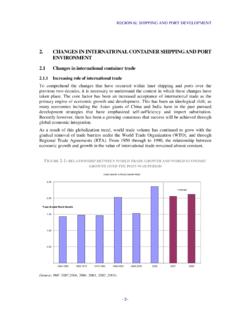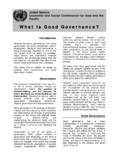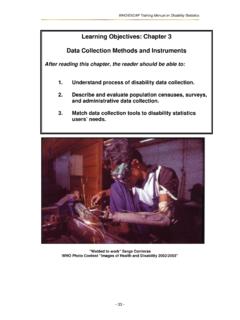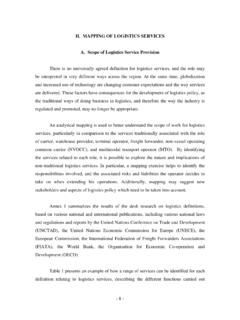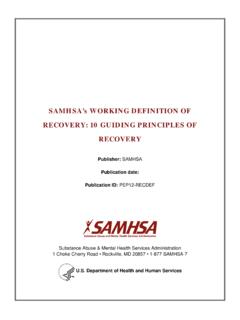Transcription of Introduction to Systems Thinking Principles and Analytical ...
1 Introduction to Systems Thinking Principles and Analytical ToolsWhat is a Systems Perspective?By fixating on the parts of a system, we miss understanding the whole unintended consequences Lacking a Systems the solution to one problem can easily lead to a new and bigger problem later on or somewhere else in the systemSystems Thinking System mindsets are needed for dealing with complex problem solving 4 fundamental concepts: INTERCONNECTEDNESS SYNTHESIS FEEDBACK LOOPS CAUSALITYS ynthesis sees the interconnectednessSynthesisIs about understanding the whole and the parts at the same time, along with the relationships and the connections that make up the dynamics of the whole.
2 AnalysisIs about dissection of complexity into manageable components. Analysis fits into the mechanical and reductionist worldview, where the world is broken down into partsWhat is Systems Thinking ?9 Systems Thinking is a vantage point from which you see a whole, a web of relationships, rather than focusing only on the detail of any particular piece. Events are seen in the larger context of a pattern that is unfolding over time. isee Systems , inc. Systems Thinking is a perspective of seeing and understanding Systems as wholes rather than as collections of parts.
3 A whole is a web of interconnections that creates emerging patterns. Peter SengeEventsWhat s happening?Patterns of BehaviorWhat s been happening?What are the trends?What changes have occurred?StructuresWhat has influenced the patterns?(rules, lesson plans, curriculum)What are the relationships among the parts? mental ModelsWhat values, beliefs, and assumptions do you have about teaching? What is seenWhat is generally unseenL e a r n i n g Lever age Systems Thinking helps us to .. move the focus away from eventsand patterns of behavior (which are symptoms of problems)and toward systemic structure and the underlying mental modelsSource: Senge, Peter, The Fifth Discipline, Thinking helps us to.
4 To find the most important places for intervention to change the long term behaviour of a system. Source: Senge, Peter, The Fifth Discipline, is quality of life perceived? Materialism or wellness?Car OwnershipEventsWhat s happening?Patterns of BehaviorWhat s been happening?What are the trends?What changes have occurred?StructuresWhat has influenced the patterns?(rules, lesson plans, curriculum)What are the relationships among the parts? mental ModelsWhat values, beliefs, and assumptions do you have about teaching?
5 What is seenWhat is generally unseenL e a r n i n g Lever age OSAre there transportation alternatives that can compete with car ownership in terms of perceived QoL?A Systems approach is to .. 1. Identify a system -After all, not all things are Systems . Some Systems are simple and predictable, while others are complex and dynamic. Most human social Systems are the Explain the behavior or properties of the whole system -This focus on the whole is the process of synthesis. Analysis looks into things while synthesis looks out of Explain the behavior or properties of the question to be explained in terms of the role(s) or function(s) of the Tools of Systems ThinkingKey Messages Policymaking at the national and local level is a difficult, complex challenge.
6 It is necessary to understand and appreciate the systemic factors and relationships that ultimately impact the processes used by decision makers. Systems Thinking requires a local, multi perspective, participatory and iterative approach to be effective. A systemic approach provides a suitable environment for good policy / decision making. Having good visual, dynamic and responsive tools is also necessary to strengthen effective policy decisions. Systems Thinking can thereforestrengthen policy making for long term sustainable development.
7 Systems Thinking Recap QUIZCAUSALITYTo understand the feedback loops we need to gain perspective of causality: how one thing results in another thing in a dynamic and constantly evolving system. The cause and effect concept in system Thinking is about being able to understand the way things influence each other in a system (on agency, feedback loops, connections, and relationships) SDG 6 Interlinkages with other SDGsTarget Achieve universal and equitable access to safe and affordable drinking water for most inter linked target;Direct causal inter linkages with 42 other targets from 16 SDGS; Indirectly linked with another 38 targets.
8 Directly drive/influenced by 35 other targets and is a key driver / influencer of 7 other targets;Most strongly influenced by SDG 1 (Poverty Eradication); SDG 6 (Water & Sanitation); SDG 9 (Infrastructure & Industrialization); SDG 11 (Cities and Human Settlements); SDG 15 (Sustainable Use of Terrestrial Ecosystems); SDG 16 (Peaceful, Inclusive, and Just Societies with Accountable Institutions); and SDG 17 (Means of Implementation);Has the most direct influence on SDG 3 (Human Health and Wellbeing)Target Achieve access to adequate and equitable sanitation and hygiene and end open defecation, (special attention to the needs of women and girls).
9 Direct causal inter linkages with 35 other targets from 13 SDGS; Indirectly linked with another 26 targets;Directly drive/influenced by 25 other targets and is a key driver / influencer of 10 other targets;Most strongly influenced by SDG 1 (Poverty); SDG 6 (Water & Sanitation); SDG 9 (Resilient Infrastructure, Sustainable Industrialization & Innovation); SDG 11 (Cities and Human Settlements); and SDG 17 (Means of Implementation);Has the most direct influence on SDG 3 (Human Health and Wellbeing) and SDG 11 (Cities and Human Settlements)Target Improve water quality by reducing pollution, eliminating dumping and minimizing release of hazardous chemicals and materials, halving the proportion of untreated wastewater and substantially increasing recycling and safe reuse most inter linked target;Direct causal inter linkages with 55 other targets from 16 SDGS; Indirectly linked with another 31 targets.
10 Directly driven/influenced by 44 other targets and is a key driver / influencer of 11 other targets;Most strongly influenced by SDG 6, 8, 9, 11, 12, 16, and 17 Has the most direct influence on SDG 3 (Human Health and Wellbeing); SDG 6 (Water & Sanitation); SDG 14 (Sustainable Use of Oceans); and SDG 15 (Sustainable Use of Terrestrial Ecosystems)Target Substantially increase water use efficiency across all sectors and ensure sustainable withdrawals and supply of freshwater to address water scarcity and substantially reduce the number of people suffering from water scarcityDirect causal inter linkages with 41 other targets from 14 SDGS; Indirectly linked with another 31 targets;Directly driven/influenced by 34 other targets and is a key driver / influencer of 7 other targets.
